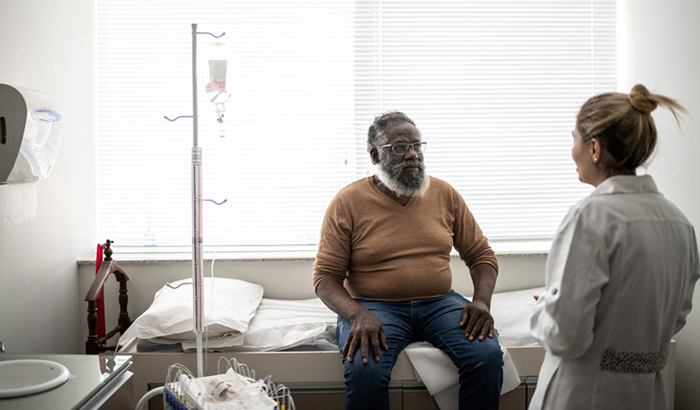The average life expectancy of Black and African-American people in the U.S. is four years shorter than that of white people, and some members of racial and ethnic minority groups experience a higher burden of preventable disease, death, and disability compared with non-Hispanic white individuals. 1 The COVID-19 pandemic has starkly illustrated the disproportionate and severe consequences that health inequities can have on communities of color, with Black, African-American, Hispanic, Latino, American Indian, and Alaska Native populations in the U.S. experiencing higher rates of hospitalization and death than white populations.2
As our nation becomes more diverse, the proportion of minority Veterans is expected to increase from 23% in 2017 to 34% in 2040. 3 Health equity ensures that a patent’s racial, ethnic, gender, and socioeconomic status do not affect the quality of their care or treatment. VA is committed to eliminating racial and ethnic disparities in its healthcare system to ensure that every Veteran has equal access to healthcare and an equal opportunity to live a long and healthy life.
VA initiatives to help achieve that goal include HSR&D’s Center for Health Equity Research and Promotion and the Charleston Health Equity and Rural Outreach Innovation Center, which work to improve the equity and accessibility of healthcare for minority and rural Veteran populations. In addition, HSR&D’s Quality Enhancement Research Initiative (QUERI) supports several programs that focus on access and health equity, working with stakeholders to deploy and evaluate implementation and quality improvement strategies to optimize care for all Veterans.
Following are some recent VA studies related to providing optimal healthcare for minority Veterans.

©iStock/FG Trade
Compared to white Veterans with chronic kidney disease (CKD), Black Veterans with CKD are twice as likely to progress to end-stage renal disease. Lower socioeconomic status, exposure to environmental toxins, limited access to high-quality healthcare, and health beliefs and behaviors all contribute to the racial disparities observed among Black individuals with CKD. Despite increasing evidence of racial health disparities and mounting indications of healthcare inequalities in the U.S., research that explores the healthcare experiences of Black Veterans with CKD is limited.
About this Study
This qualitative study investigated the healthcare experiences of Black Veterans with CKD and identified and explored the racial discrimination they encountered. Researchers interviewed 36 Black Veterans with CKD who received care at the Corporal Michael J. Crescenz VA Medical Center’s renal clinics from 2018 to 2019. Interviews of 30 to 60 minutes were conducted by a Black male principal investigator and a Black male research assistant before or after appointments or during dialysis. Interviews centered around three open-ended questions: 1) What are some examples of racism you have experienced by a doctor? 2) What are some examples of racism you have experienced by someone who works at the hospital who is not your doctor? and 3) How do you think racism affects your health?
Findings
Implications
Black Veterans with CKD who participated in this study described healthcare experiences that were retraumatizing and worsened their psychological and physical responses to racism, potentially exacerbating CKD symptoms. Findings highlight an important need to educate and train providers in implementing approaches to care that address race-based stress and trauma. Implementing care models that acknowledge racism as a traumatic experience is one way VA and other healthcare institutions can lead the nation in developing anti-discriminatory healthcare.
Principal Investigator
 Kevin A. Jenkins, PhD, is part of HSR&D’s Center for Health Equity Research & Promotion in Philadelphia, PA.
Kevin A. Jenkins, PhD, is part of HSR&D’s Center for Health Equity Research & Promotion in Philadelphia, PA.

©iStock/LL28
Variation by race in the accuracy of using pulse oximetry to measure blood oxygen levels has been reported as early as 1990. Recent studies have documented varying pulse oximetry accuracy between Black and white patients in intensive care units and in critically ill patients with respiratory failure. Compared to white patients, Black patients have a higher prevalence of occult hypoxemia—arterial blood oxygen saturation (SaO2) of less than 88% despite a pulse oximetry (SpO2) reading greater than or equal to 92%.
About this Study
The objective of this multicenter, retrospective cohort study was to evaluate measurement discrepancies by race between SpO2 and SaO2 among inpatients not in intensive care. Using VA data from 2013–2019, investigators identified 30,039 pairs of SpO2 and SaO2 measurements completed within 10 minutes of each other among general medical and surgical VA inpatients. The primary outcome was occult hypoxemia and variation in occult hypoxemia by race and ethnicity.
Findings
Implications
Principal Investigators

Hallie C. Prescott, MD, MSc (left) Theodore J. Iwashyna, MD, PhD (right) |
Hallie C. Prescott, MD, MSc, Thomas S. Valley, MD, MSc, and Sarah Seelye, PhD, are part of HSR&D’s Center for Clinical Management Research in Ann Arbor, MI. Theodore J. Iwashyna, MD, PhD, is with Johns Hopkins Medicine. |

©iStock/FatCamera
Hypertension—which can lead to stroke, heart attack, chronic kidney disease, and heart failure—is the most common chronic condition among Veterans, affecting 37% of patients. Compared to the white population in the U.S., hypertension among Black individuals tends to occur earlier in life, be more prevalent, and is less likely to be controlled. Although blood pressure (BP) control of systolic/diastolic BP <140/90 mmHg has significantly improved among Veterans (from 46% in 2000 to 76% in 2017), disparities in BP control persist, and reasons for the disparities are not well understood.
Current hypertension management guidelines recommend reducing systolic BP to <130 mmHg to lower risk of cardiovascular events and mortality in Black and non-Black patients. However, the extent to which systolic BP control of <130 mmHg is achieved overall and by race and ethnicity in VA healthcare is unknown.
About this Study
The objectives of this study were to:
Researchers conducted a retrospective study of 16,768 Black and 65,366 white Veterans with hypertension from VA facilities nationwide who began hypertension medication between 2014 and 2020, examining outcomes of prescriptions for guideline-recommended medications and controlled hypertension one year after initiation of hypertension treatment.
Preliminary Findings
Expected Implications
Preliminary findings suggest there is a need for evidence-based strategies to advance implementation of the most recently recommended BP control targets. In addition, findings suggest that the racial and ethnic gap in BP control may be greater among those who have untreated hypertension or who have been on antihypertensive medications for greater than one year. Additional research will help identify the causes of blood pressure-related race and ethnic disparities and ultimately help develop an informatics strategy to support high quality, equitable hypertension management for all Veterans.
Principal Investigator
 April F. Mohanty, PhD, MPH, is with HSR&D’s Informatics, Decision-Enhancement and Analytic Sciences Center in Salt Lake City, UT.
April F. Mohanty, PhD, MPH, is with HSR&D’s Informatics, Decision-Enhancement and Analytic Sciences Center in Salt Lake City, UT.
Publications
Recent publications of Dr. Mohanty’s work with colleagues include:
Bress A, Cohen J, Mohanty A, et al. Inequities in hypertension control in the United States exposed and exasperated by COVID-19 and the role of home blood pressure and virtual health care during and after the COVID-19 pandemic. Journal of the American Heart Association. May 19, 2021;10:e020997.

©iStock/Prostock-Studio
Compared to other racial and ethnic groups, non-Hispanic African Americans have an earlier onset and higher prevalence of hypertension as well as a disproportionately higher risk of complications, leading to higher rates of cardiovascular morbidity and mortality. In addition, African Americans have been under-represented in technology-assisted interventions, and trials that use texting for hypertension self-management in Veterans have not been conducted.
A technology-assisted intervention called peer narratives engages listeners through personally relevant content and has been shown to promote lifestyle change and effective self-management among patients with hypertension. For example, African-American Veterans who watched videos of Veteran narratives related to hypertension self-management showed significant differences in their intention to change hypertension management behavior immediately after video viewing. However, effects on blood pressure were not sustained, and six-month outcomes revealed only a modest benefit, highlighting the need for longitudinal support to sustain the storytelling effect.
About this Study
Researchers in this ongoing project (May 2019–October 2023) are studying the impact of the “Continuing the Conversation” (CTC) intervention, in which Veterans watch online videos of African-American Veterans sharing challenges and successes of hypertension self-management. Veteran participants select the storyteller whose narrative they find most relevant, and then over six months receive longitudinal texting support that incorporates quotations and themes from the videos to reinforce healthful self-management behaviors. Researchers aim to:
Initial Findings and Successes Include:
Expected Implications
Longitudinal texts are designed to bring the storyteller back into the Veteran’s everyday life, reminding and reinforcing as Veterans engage in the numerous daily decisions that will affect their blood pressure and their lives. Incorporating peer content into text messages in this way is highly innovative and offers a promising approach to support Veterans.
During and following this trial, researchers will provide materials to their operational partner, the Office of Connected Care (OCC), for presentations to the National Leadership Council including VISN directors and will explore other avenues for dissemination. Additionally, researchers will work with OCC to create an electronic health record-based referral tool to encourage clinical teams to enroll patients in CTC and will explore mechanisms by which Veterans can request to enroll.
Principal Investigator
 Sarah L. Cutrona, MD, MPH, is associate director of HSR&D’s Center for Healthcare Organization & Implementation Research in Bedford, MA.
Sarah L. Cutrona, MD, MPH, is associate director of HSR&D’s Center for Healthcare Organization & Implementation Research in Bedford, MA.
Publications
Recent publications of Dr. Cutrona’s work with colleagues include:
DeLaughter K, Fix G, Cutrona S, et al. Incorporating African-American Veterans’ success stories for hypertension management: developing a behavioral support texting protocol. JMIR Research Protocols. December 2021;10(12):e29423.